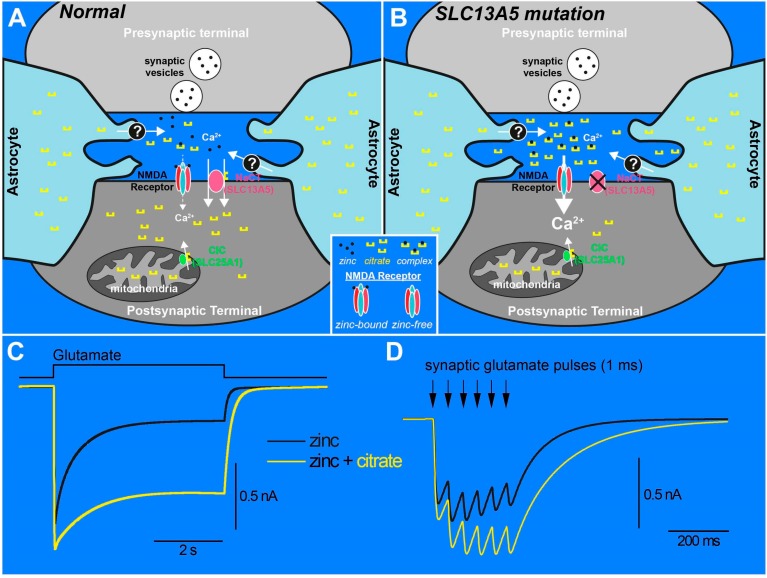Figure 3.
The possible role of zinc and NMDA receptors in loss-of-function SLC13A5 mutations. (A) normal condition. Astrocytes release citrate (yellow U-shaped symbols) into the extracellular space via an unknown mechanism (denoted by a question mark). The extracellular zinc binding site on the NR2A subunit (red) of the NMDA receptor is occupied by zinc ions (black filled circles), acting as a check on NMDA receptor-induced calcium influx. The plasma membrane citrate transporter NaCT (SLC13A5, pink) limits the accumulation of extracellular citrate by transporting citrate into the cytoplasm. Citrate extrusion from the mitochondria via the mitochondrial citrate carrier (CIC or SLC25A1, green) is also a source of cytosolic citrate; (B) When SLC13A5 function is lost, intracellular citrate levels are likely reduced while extracellular citrate levels rise to pathologically high levels. Citrate chelation of free zinc reduces the availability of zinc for the NMDA receptor, relieving the negative allosteric effect of zinc on NMDA receptor function, thereby increasing calcium flux through the NMDA receptor (note larger arrow indicating enhanced flux of calcium through the NMDA receptor). Schematics in A and B were motivated from [30,61]; (C) kinetic model simulations [55,62] of NMDA receptor currents generated by a 5 s pulse of glutamate under normal conditions (i.e., with free zinc) and under conditions in which extracellular citrate has chelated free zinc (i.e., without free zinc). Citrate chelation induces a larger and more sustained NMDA receptor current; (D) response of the kinetic model to six synaptic-like 1-ms pulses of glutamate, simulating a burst of gluatmatergic synaptic activity. Note that NMDA receptor-mediated currents summate and deactivate more slowly under conditions of elevated extracellular citrate levels than under the normal conditions. These simulations demonstrate that increased extracellular citrate levels have the potential to enhance NMDA receptor-mediated synaptic transmission, which is likely to yield pro-convulsant effects.

